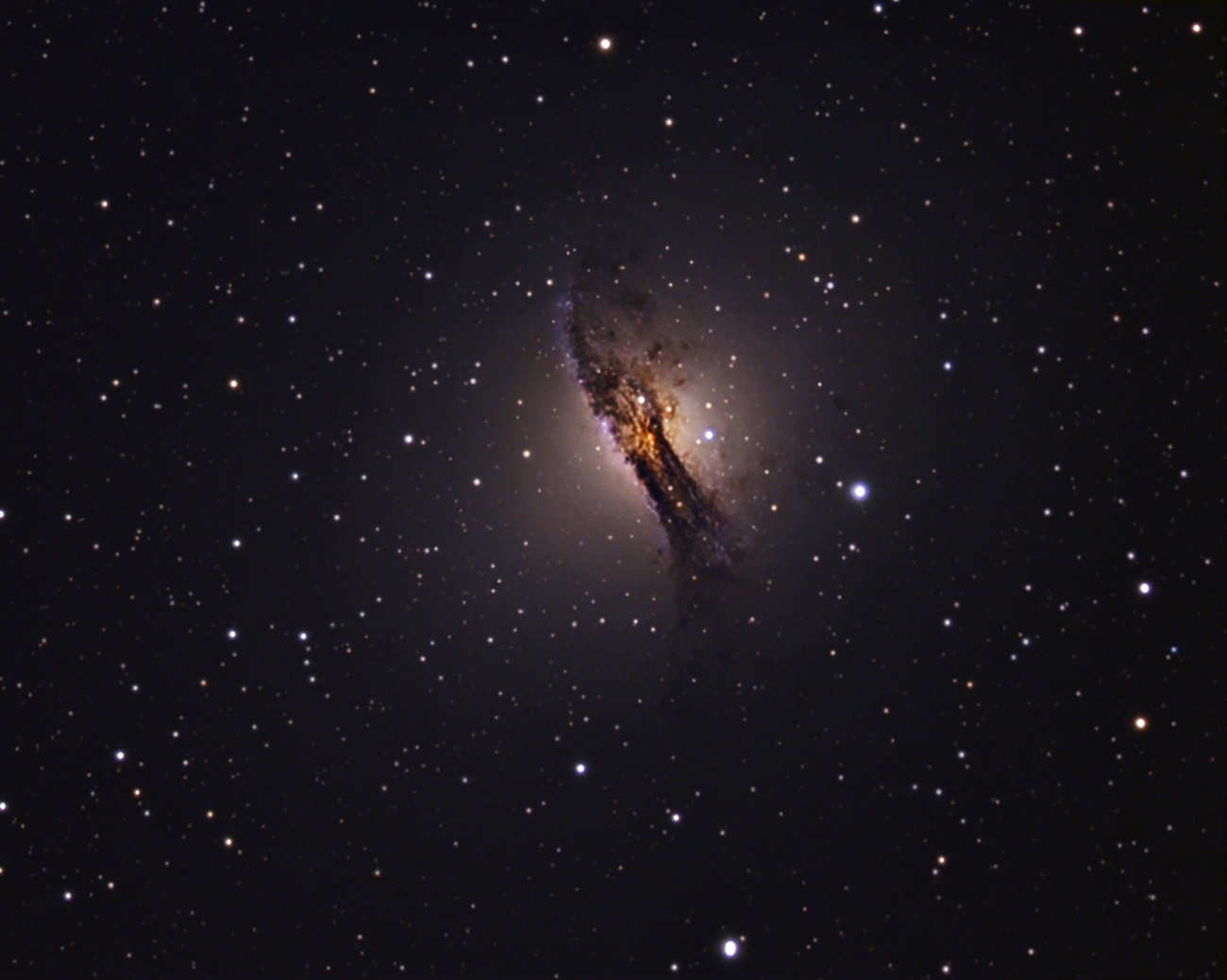
| HOME |
NGC 5128 - CENTAURUS A
RADIO GALAXY
(ra: 13.25,5/ dec -43:01)

DATA
TYPE: Galaxy
VISUAL BRIGHTNESS: 7
Apparent Diameter: 18,2 arc minutes
DISTANCE: 12.5 Millions lights years
IMAGE INFORMATION
SCOPE: Celestron C8 SCT working at f6 (roughly)
CAMERA: SXVF H9
GUIDING: William Optics Zenithstar 66 with WO 0.8 x fr/ff
IMAGE ACQUISITION: AstroArt 3.0 - Control Interface 3.72 plug in
FILTERS: Astronomik Type II - Astronomik Ha 6 nm - Atik Filter Wheel
SKY CONDITIONS: transparency and seeing regular
EXPOSURES: LRGB (60,15,15,20)
PROCESSING: Maxim SD Mask, Images Plus CCD Sharp, Photoshop CS2
NGC 5128 ( Centarus A) Text courtesy (and with permission) of Robert Gendler
NGC 5128 is the nearest large elliptical galaxies to our sun. It is also the nearest of the giant radio galaxies, possessing an active galactic nucleus (AGN) and optically one of the most luminous galaxies in the sky. Among many other things NGC 5128 is also the prototypical postmerger elliptical galaxy. Structural peculiarities including the prominent rotating disk of stars and gas and the complex shell structure of its halo point to a large scale merger within the last billion years. Its proximity offers astronomers a unique opportunity for a detailed look into the peculiar formation histories of these giant stellar agglomerations. Strikingly apparent within the galaxy are two major components, a large elliptical structure which generates about 90% of the luminosity and a massive disk of stars, dust and gas. The odd appearance supports the premise that a large scale merger of an elliptical galaxy with a large barred disk galaxy occurred to form NGC 5128 within the last billion years. Tidal streams of young stars have also been identified in the halo of NGC 5128 thought to have occurred by cannibalization of a nearby gas rich dwarf galaxy some 300 million years ago, long after the large scale merger. Elliptical galaxies are typically devoid of gas, dust and young stars. The unexpected presence of gas rich disk elements within the structure of NGC 5128 supports the current belief that accretions and mergers of low mass galaxies may be an important agent in the evolution of galaxy formation.
NGC 5128 has many similarities to the giant elliptical galaxy M87 including a unique population of globular clusters which likely tell the tale of its complex history. Scattered throughout the halo of NGC 5128 are some 2000 globular clusters, more than 3 times the total number of globular clusters within our local group of galaxies. A subset of its globular clusters are more massive than any of the clusters in our local group and appear to bridge the gap between the most massive star clusters and the lowest mass galaxies. These massive globular clusters are also significantly younger (5 billion years) than the galaxy itself. The findings suggest that many of the clusters are not intrinsic to the galaxy but may actually be the nuclei of tidally stripped dwarf galaxies devoured by the galaxy in its remote past. The possibility that massive globular clusters are the nuclei of dwarf galaxies may help explain the presence of black holes in some massive globular clusters such as G1 in M31.
In 1949, NGC 5128 was found to be a loud source of radio energy, in fact the loudest radio source in its region of the sky (second overall to Cygnus A) , earning it the designation Centarus A. As a radio galaxy it releases 1000 times the radio energy of the Milky Way in the form of large bi-directional radio lobes that extend some 800,000 light years into intergalactic space. The source of the radio emission is very compact, about 10 light days across and is believed to be a supermassive black hole in the galaxy's center with a total mass of 200 million to possibly one billion suns. As a radio galaxy, NGC 5128 belongs to the subgroup of galaxies called Active Galaxies, which include Quasars, Seyfert galaxies, Blazars and and Radio Galaxies. Active galaxies are distinguished by their prodigious energy output which cannot be explained by their stellar populations and must have another source. Active galaxies have in common an "Active Galactic Nucleus (AGN)" which is believed responsible for their prodigious energy output. Supermassive black holes are almost certainly the central engines of Active Galactic Nuclei, powering the enormous outflows of energy which characterize this subgroup of bright galaxies. Like most active galaxies, NGC 5128 shows high velocity bi-directional jet phenomenon arising from its nucleus. The jets represent streams of multimillion degree plasma leaving the nucleus at extremely high velocities. The streams of hot gas are thought to be released when matter is accreted by the supermassive black hole at the galaxy's center.
See also Robert Gendler 140 essays and information about 140 of the most popular northern and southern objects HERE
NGC 5128 - CENTAURUS A
close up - crop from original